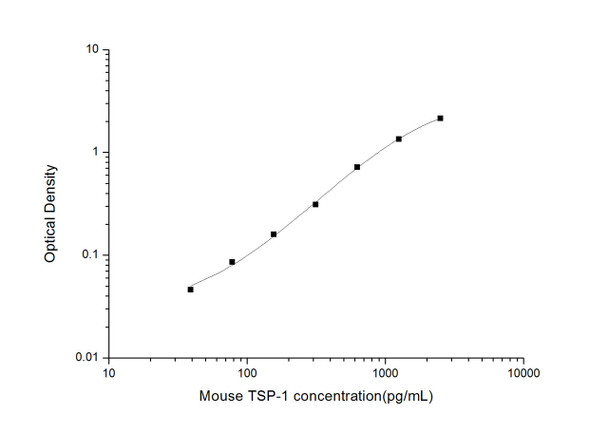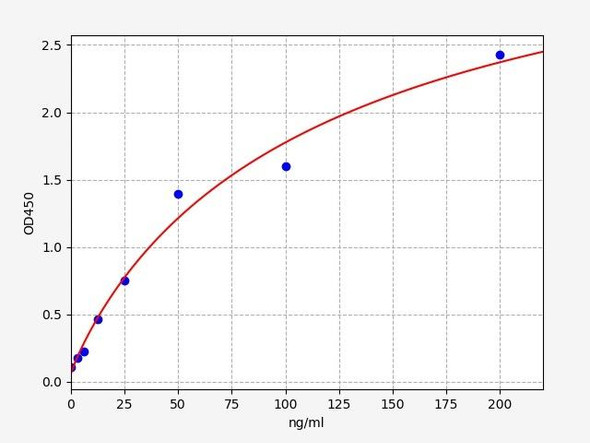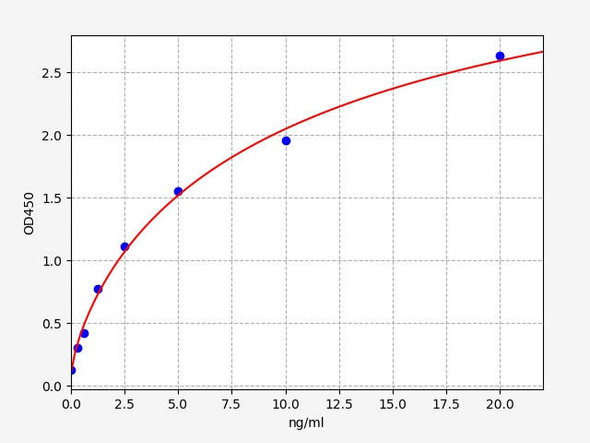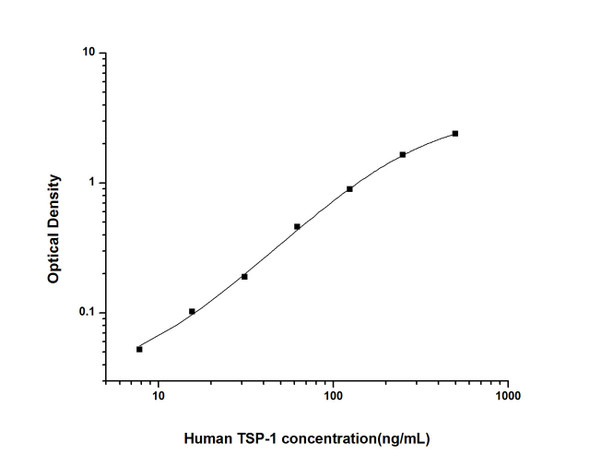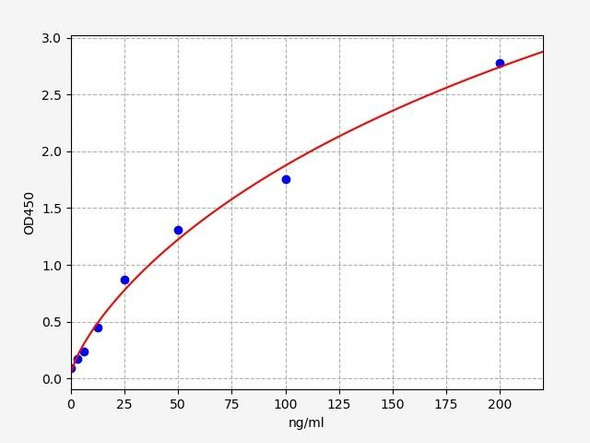Mouse Cell Biology ELISA Kits 2
Mouse TSP-1 (Thrombospondin 1) ELISA Kit (MOES01544)
- SKU:
- MOES01544
- Product Type:
- ELISA Kit
- Size:
- 96 Assays
- Uniprot:
- P35441
- Sensitivity:
- 23.44pg/mL
- Range:
- 39.06-2500pg/mL
- ELISA Type:
- Sandwich
- Synonyms:
- THBS1 , THBS-1, TSP, TSP1, Thrombospondin-1p180
- Reactivity:
- Mouse
- Sample Type:
- Serum, plasma and other biological fluids
- Research Area:
- Cell Biology
Description
| Assay type: | Sandwich |
| Format: | 96T |
| Assay time: | 4.5h |
| Reactivity: | Mouse |
| Detection Method: | Colormetric |
| Detection Range: | 39.06-2500 pg/mL |
| Sensitivity: | 23.44 pg/mL |
| Sample Volume Required Per Well: | 100µL |
| Sample Type: | Serum, plasma and other biological fluids |
| Specificity: | This kit recognizes Mouse TSP-1 in samples. No significant cross-reactivity or interference between Mouse TSP-1 and analogues was observed. |
This ELISA kit uses Sandwich-ELISA as the method. The micro ELISA plate provided in this kit has been pre-coated with an antibody specific to Mouse TSP-1. Standards or samples are added to the appropriate micro ELISA plate wells and combined with the specific antibody. Then a biotinylated detection antibody specific for Mouse TSP-1 and Avidin-Horseradish Peroxidase (HRP) conjugate are added to each micro plate well successively and incubated. Free components are washed away. The substrate solution is added to each well. Only those wells that contain Mouse TSP-1, biotinylated detection antibody and Avidin-HRP conjugate will appear blue in color. The enzyme-substrate reaction is terminated by adding Stop Solution and the color turns yellow. The optical density (OD) is measured spectrophotometrically at a wavelength of 450 nm ± 2 nm. The OD value is proportional to the concentration of Mouse TSP-1. The concentration of Mouse TSP-1 in samples can be calculated by comparing the OD of the samples to the standard curve.
| UniProt Protein Function: | THBS1: Adhesive glycoprotein that mediates cell-to-cell and cell-to-matrix interactions. Binds heparin. May play a role in dentinogenesis and/or maintenance of dentin and dental pulp. Ligand for CD36 mediating antiangiogenic properties. Belongs to the thrombospondin family. |
| UniProt Protein Details: | Protein type:Inhibitor; Motility/polarity/chemotaxis Chromosomal Location of Human Ortholog: 2 E5|2 59. 34 cM Cellular Component: cell surface; cytoplasm; endoplasmic reticulum; external side of plasma membrane; extracellular matrix; extracellular space; fibrinogen complex; sarcoplasmic reticulum; secretory granule Molecular Function:extracellular matrix binding; fibroblast growth factor binding; fibronectin binding; heparin binding; integrin binding; laminin binding; low-density lipoprotein binding; phosphatidylserine binding; protein binding; transforming growth factor beta binding Biological Process: activation of MAPK activity; behavioral response to pain; blood vessel morphogenesis; cell cycle arrest; cell migration; engulfment of apoptotic cell; inflammatory response; negative regulation of angiogenesis; negative regulation of antigen processing and presentation of peptide or polysaccharide antigen via MHC class II; negative regulation of apoptosis; negative regulation of blood vessel endothelial cell migration; negative regulation of caspase activity; negative regulation of cell-matrix adhesion; negative regulation of dendritic cell antigen processing and presentation; negative regulation of endothelial cell proliferation; negative regulation of fibrinolysis; negative regulation of fibroblast growth factor receptor signaling pathway; negative regulation of interleukin-12 production; peptide cross-linking; positive regulation of angiogenesis; positive regulation of blood coagulation; positive regulation of blood vessel endothelial cell migration; positive regulation of cell migration; positive regulation of cell proliferation; positive regulation of chemotaxis; positive regulation of macrophage activation; positive regulation of phosphorylation; positive regulation of protein kinase B signaling cascade; positive regulation of smooth muscle cell proliferation; positive regulation of transforming growth factor beta receptor signaling pathway; positive regulation of translation; positive regulation of tumor necrosis factor biosynthetic process; regulation of cGMP metabolic process; response to calcium ion; response to glucose stimulus; response to magnesium ion; response to mechanical stimulus; sprouting angiogenesis |
| NCBI Summary: | The protein encoded by this gene is a subunit of a disulfide-linked homotrimeric protein. This protein is an adhesive glycoprotein that mediates cell-to-cell and cell-to-matrix interactions. This protein can bind to fibrinogen, fibronectin, laminin, type V collagen and integrins alpha-V/beta-1. This protein has been shown to play roles in platelet aggregation, angiogenesis, and tumorigenesis. Alternative splicing results in multiple transcript variants encoding different isoforms. [provided by RefSeq, Sep 2015] |
| UniProt Code: | P35441 |
| NCBI GenInfo Identifier: | 549134 |
| NCBI Gene ID: | 21825 |
| NCBI Accession: | P35441. 1 |
| UniProt Related Accession: | P35441 |
| Molecular Weight: | |
| NCBI Full Name: | Thrombospondin-1 |
| NCBI Synonym Full Names: | thrombospondin 1 |
| NCBI Official Symbol: | Thbs1 |
| NCBI Official Synonym Symbols: | TSP1; TSP-1; tbsp1; Thbs-1 |
| NCBI Protein Information: | thrombospondin-1 |
| UniProt Protein Name: | Thrombospondin-1 |
| Protein Family: | Thrombospondin |
| UniProt Gene Name: | Thbs1 |
As the OD values of the standard curve may vary according to the conditions of the actual assay performance (e. g. operator, pipetting technique, washing technique or temperature effects), the operator should establish a standard curve for each test. Typical standard curve and data is provided below for reference only.
| Concentration (pg/mL) | O.D | Average | Corrected |
| 2500 | 2.215 2.255 | 2.235 | 2.145 |
| 1250 | 1.426 1.452 | 1.439 | 1.349 |
| 625 | 0.823 0.795 | 0.809 | 0.719 |
| 312.5 | 0.397 0.407 | 0.402 | 0.312 |
| 156.25 | 0.262 0.238 | 0.25 | 0.16 |
| 78.13 | 0.179 0.173 | 0.176 | 0.086 |
| 39.06 | 0.134 0.138 | 0.136 | 0.046 |
| 0 | 0.088 0.092 | 0.09 | -- |
Precision
Intra-assay Precision (Precision within an assay): 3 samples with low, mid range and high level Mouse TSP-1 were tested 20 times on one plate, respectively.
Inter-assay Precision (Precision between assays): 3 samples with low, mid range and high level Mouse TSP-1 were tested on 3 different plates, 20 replicates in each plate.
| Intra-assay Precision | Inter-assay Precision | |||||
| Sample | 1 | 2 | 3 | 1 | 2 | 3 |
| n | 20 | 20 | 20 | 20 | 20 | 20 |
| Mean (pg/mL) | 138.78 | 231.78 | 1242.08 | 132.18 | 214.00 | 1266.64 |
| Standard deviation | 9.05 | 9.43 | 44.84 | 8.08 | 12.13 | 46.74 |
| C V (%) | 6.52 | 4.07 | 3.61 | 6.11 | 5.67 | 3.69 |
Recovery
The recovery of Mouse TSP-1 spiked at three different levels in samples throughout the range of the assay was evaluated in various matrices.
| Sample Type | Range (%) | Average Recovery (%) |
| Serum (n=5) | 84-95 | 90 |
| EDTA plasma (n=5) | 85-96 | 91 |
| Cell culture media (n=5) | 89-101 | 95 |
Linearity
Samples were spiked with high concentrations of Mouse TSP-1 and diluted with Reference Standard & Sample Diluent to produce samples with values within the range of the assay.
| Serum (n=5) | EDTA plasma (n=5) | Cell culture media (n=5) | ||
| 1:2 | Range (%) | 97-111 | 96-111 | 96-109 |
| Average (%) | 103 | 102 | 102 | |
| 1:4 | Range (%) | 88-100 | 84-94 | 83-97 |
| Average (%) | 93 | 89 | 90 | |
| 1:8 | Range (%) | 86-100 | 82-97 | 86-99 |
| Average (%) | 93 | 89 | 91 | |
| 1:16 | Range (%) | 90-102 | 85-97 | 86-99 |
| Average (%) | 95 | 91 | 91 |
An unopened kit can be stored at 4°C for 1 month. If the kit is not used within 1 month, store the items separately according to the following conditions once the kit is received.
| Item | Specifications | Storage |
| Micro ELISA Plate(Dismountable) | 8 wells ×12 strips | -20°C, 6 months |
| Reference Standard | 2 vials | |
| Concentrated Biotinylated Detection Ab (100×) | 1 vial, 120 µL | |
| Concentrated HRP Conjugate (100×) | 1 vial, 120 µL | -20°C(shading light), 6 months |
| Reference Standard & Sample Diluent | 1 vial, 20 mL | 4°C, 6 months |
| Biotinylated Detection Ab Diluent | 1 vial, 14 mL | |
| HRP Conjugate Diluent | 1 vial, 14 mL | |
| Concentrated Wash Buffer (25×) | 1 vial, 30 mL | |
| Substrate Reagent | 1 vial, 10 mL | 4°C(shading light) |
| Stop Solution | 1 vial, 10 mL | 4°C |
| Plate Sealer | 5 pieces | |
| Product Description | 1 copy | |
| Certificate of Analysis | 1 copy |
- Set standard, test sample and control (zero) wells on the pre-coated plate and record theirpositions. It is recommended to measure each standard and sample in duplicate. Note: addall solutions to the bottom of the plate wells while avoiding contact with the well walls. Ensuresolutions do not foam when adding to the wells.
- Aliquot 100µl of standard solutions into the standard wells.
- Add 100µl of Sample / Standard dilution buffer into the control (zero) well.
- Add 100µl of properly diluted sample (serum, plasma, tissue homogenates and otherbiological fluids) into test sample wells.
- Cover the plate with the sealer provided in the kit and incubate for 90 min at 37°C.
- Aspirate the liquid from each well, do not wash. Immediately add 100µL of BiotinylatedDetection Ab working solution to each well. Cover the plate with a plate seal and gently mix. Incubate for 1 hour at 37°C.
- Aspirate or decant the solution from the plate and add 350µL of wash buffer to each welland incubate for 1-2 minutes at room temperature. Aspirate the solution from each well andclap the plate on absorbent filter paper to dry. Repeat this process 3 times. Note: a microplatewasher can be used in this step and other wash steps.
- Add 100µL of HRP Conjugate working solution to each well. Cover with a plate seal andincubate for 30 min at 37°C.
- Aspirate or decant the solution from each well. Repeat the wash process for five times asconducted in step 7.
- Add 90µL of Substrate Reagent to each well. Cover with a new plate seal and incubate forapproximately 15 min at 37°C. Protect the plate from light. Note: the reaction time can beshortened or extended according to the actual color change, but not by more than 30min.
- Add 50 µL of Stop Solution to each well. Note: Adding the stop solution should be done inthe same order as the substrate solution.
- Determine the optical density (OD value) of each well immediately with a microplate readerset at 450 nm.

